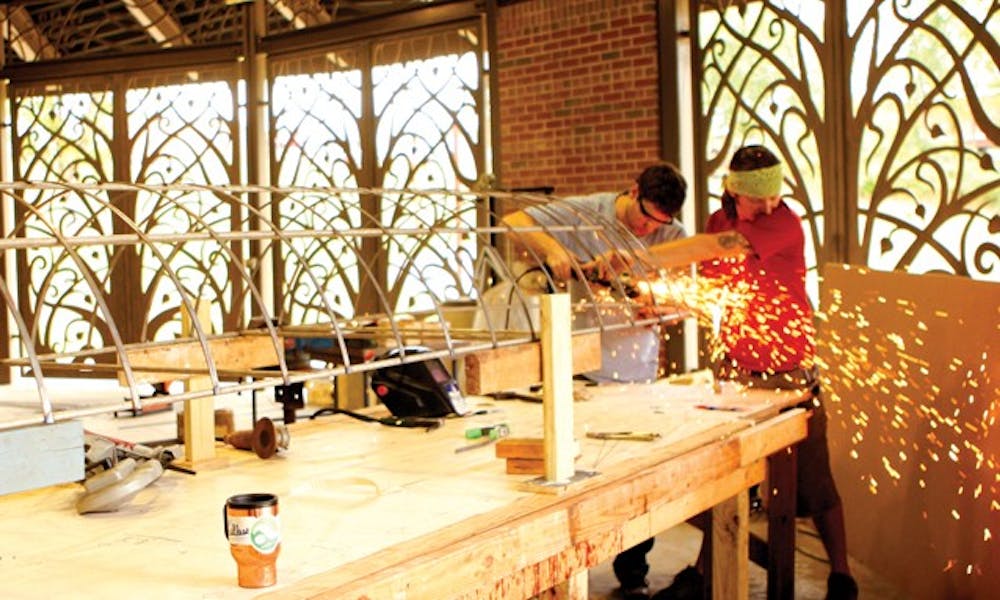Musician and artist Satch Hoyt is spending this week as an artist in residence at the Nasher Museum of Art. Hoyt is currently working on “Celestial Vessel,” a 16-foot canoe incorporating RCA records and an original soundscape, for inclusion in the Nasher’s August 2010 exhibition The Record. recess’ Tina Siadak caught up with the artist this week to talk about pop culture, “Celestial Vessel” and more.
Your project, “Celestial Vessel,” is part of the Nasher’s upcoming exhibition The Record, which focuses on the culture of the vinyl record in contemporary art. What has been your personal experience with the vinyl record? The vinyl is a signifier and transmitter of information. I grew up in the 1970s and there was a lot of politicized music. African-American culture was influencing the whole African diaspora. Also, there was a tactile ritual related to the listening experience you don’t have now. No one knows who or what they’re listening to today. Being a musician, I learned to play from listening to records.
Do you think the vinyl has a future in pop culture or is it more of a historical symbol now? DJs are always going to want to use vinyl. So in DJ culture, we won’t lose vinyl. As long as people are still tuned into that, vinyl will live. Independent musicians still strive to get that 12-inch white label record to DJs. There’s something prestigious about that.
“Celestial Vessel” is a 16-foot canoe made out of vinyl records. What was your inspiration for creating this structure? The vessel seeks to investigate various pertinent issues such as displacement, rootlessness and abandonment, also acknowledging the fact that belief systems and music held elements of the culture intact. Part of my mission is to mine history and find materials that no one else has used in the contemporary art world. These RCA Victor Red Seal vinyls were only released for about four years. I discovered them at a New York flea market three or four years ago. The canoe is a symbol of the Middle Passage and the African diaspora. It was the first vessel of slavery. Traders used canoes to transport slaves down the rivers to the slave ships.
How will the soundscape you are composing for “Celestial Vessel” play into the exhibition? The soundscape hasn’t been created yet, but for sure I will be sampling from some of these Red Seal records. I always do the soundscape after the work has been completed. The soundscape for “The Don Kingdom: In the Corner”—I was able to record Muhammad Ali on the heavy bag and Sugar Ray Robinson jumping rope. I mixed that together with DJ Spinna to create a hip-hop beat. “Celestial Vessel” is an extremely complex piece because it represents a timeline stretching from the slave ship to now.
You have exhibited work all over the world. Are there different cultural reactions to your art? Some of my work would never translate outside of the United States. New York is the seat of the black intelligentsia—there’s an arena there, a platform. The black intelligentsia has to come here. This is where there is reception. A piece like “Brown v. Board of Education” wouldn’t resonate if I showed it in Germany. There isn’t that knowledge. “Celestial Vessel” would resonate in the U.K., but not the same as in the United States.
What impact do you hope your work has on the viewer? I am dedicated to making works with sociopolitical layers, but once it goes out there, it has a life of its own. But if people start asking question they can become enlightened witnesses. I like to think I am provoking with my work.
Hoyt will appear tomorrow at a public reception from 7 to 9 p.m. at Liberty Arts, 401-B. Foster St., as part of the monthly Third Friday festivities. The artist will also give a talk today at 12:30 p.m. in room 240 of the Franklin Center, 2204 Erwin Rd., entitled “Hybrid Navigations in a Galaxy of Souls.”
Get The Chronicle straight to your inbox
Signup for our weekly newsletter. Cancel at any time.

